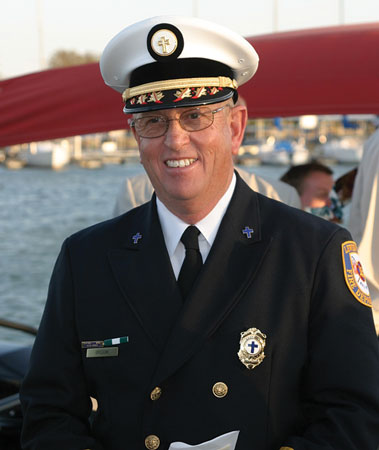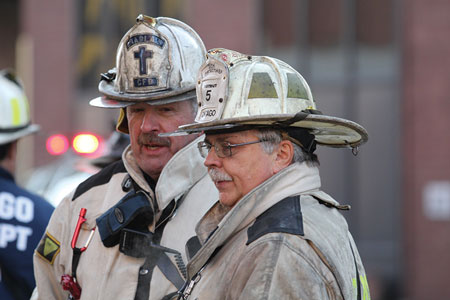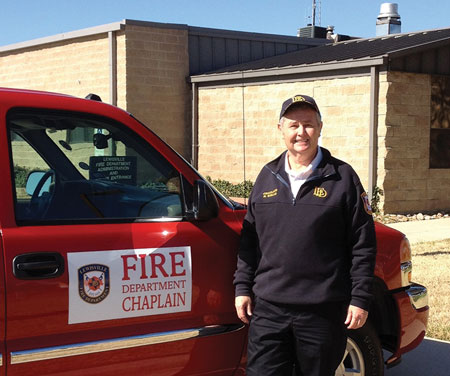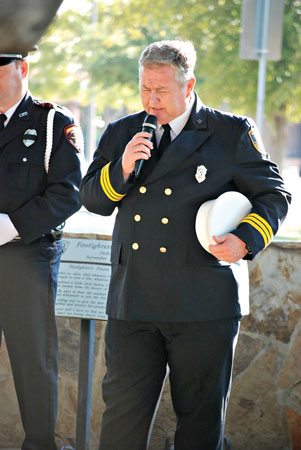
When we refer to the “silent heroes” of an organization-people who never look for recognition (the “attaboys”)-we’re often referring to our civilian staff, mechanics, chaplains, and all of those who work hard day after day to take care of us and make a difference, doing so without the fanfare, marching bands, and fireworks. So many of us get caught up in the “Look what I’ve done” or “I’ve done this” attitude that we miss out on seeing who often contributes to our successes: the silent heroes.
![(1) Lewisville (TX) Fire Department Chaplain Bennie Grissom (ret.). [Photo courtesy of the Lewisville (TX) Fire Department.]](https://emberly.fireengineering.com/wp-content/uploads/2016/03/1603FE_LaskyFeaturePic1.jpg) |
| (1) Lewisville (TX) Fire Department Chaplain Bennie Grissom (ret.). [Photo courtesy of the Lewisville (TX) Fire Department.] |
Just before leaving the southwest suburbs of Chicago to take my first chief’s job in Coeur d’Alene, Idaho, I was attending a farewell dinner, coincidentally, for our department chaplain Father Ray Clennon when Chief Paul Boecker approached me and gave me some of the best “chiefly” advice I’ve ever been given. He said, “If you want to be successful as a fire chief, you need to understand two things: You don’t run your fire department-your secretary does-and you have to have a good chaplain.” And he was right! Your secretary or administrative assistant runs the department, and the sooner you realize that and embrace it, the more successful you’ll be as a chief, and having a good chaplain is HUGE!
The Importance of a Chaplain Program
The fire service (as well as the military) has always placed a high priority on its chaplain services; we’ve realized from the beginning how important it is not just to the people we serve but to our own personnel as well. Whether it’s the chaplain’s response to one of those “bad” calls when one of our own is going through a tough time and needs a shoulder to lean on or for a department ceremony, the benefit of having a chaplain program in place is critical if we are truly going to be there for those we serve in and out of the department.
Over the years, the list of needs, tasks, and duties of the department chaplain has grown long and continues to grow every day. Following are just a few of the many ways chaplains come through for us.
Those “Bad” Calls
When we respond to an incident where someone has lost a loved one or everything he owns or has been seriously injured in an accident or a fire, our job does not end when we pick up, leave the scene, and return to quarters. For this scenario, one of the best actions you can take is to have a chaplain respond to the scene or hospital to offer the support and comfort the victim and his family need and maybe follow up with them afterward. Remember, often, neither the victim’s faith nor the house of worship he attends matters, only that someone is there for him offering assistance, someone who is not emotionally involved who can see clearly the needs or desires of those affected. This is important in helping those going through that bad time, when you need someone, such as a chaplain, whose life is wrapped around helping others and who, in most cases, has been trained in how to deal with those bad situations. I remember when there was nothing more uplifting to hear on the radio than “Father Ray is on the way” or “Brother Bennie or Brother Kenneth is en route” when I was on the scene of one of those calls.
 |
| (2) Chicago (IL) Fire Department Chaplains Rabbi Moshe Wolf (left) and Father Tom Mulcrone (right) at the scene of a multiple-alarm lumberyard fire. Rabbi Moshe is known for “breaking the ice” as he visits and blesses his firefighters by handing out lollipops. (Photo by Gordon Nord.) |
Calls that put you in a stressful situation, such as those involving children, are always traumatic to everyone involved. No matter how tough you think you are, no one is that tough; everyone has a breaking point, including the toughest firefighters. It’s not normal for a firefighter to see what he sees. Whether it’s a pin-in accident with someone screaming for his life, deceased children, or busted up bodies, it’s not normal, and it will affect everyone differently. Having a chaplain to whom you can talk and open up or lean on makes all the difference in the world. Most departments are responsible for initiating the critical incident stress debriefing (CISD) team for members who need it during and after the incident. They know whom to zero in on, what they have been going through, and whom to keep an eye on.
There may be no need to activate the CISD team after a bad call; a spontaneous, unannounced visit to the firehouse by your chaplain after that bad call can alleviate feelings of angst permeating through the station. This is where that relationship with your chaplain comes into play, where you can pick up the phone and tell him, “Hey, station 3 just had a bad baby call, and John, one of our newer members, has a baby the same age. I think he may need a casual visit over a cup of coffee.” Or, “Man, Chaplain, Station 16 can’t catch a break. That’s the fourth bad baby or kid call this month.” This is where the casual visit by your chaplain comes in handy. There’s no pressure; he just lets the crew know that he is there for them. Sometimes, the chaplain doesn’t even have to talk about the call; just the fact that the firefighters know that their chaplain has them in his thoughts may be enough. In addition, the chaplain can follow up on those members while they are off-duty as well.
The Seriously Injured or Line-of-Duty Death (LODD) Firefighter
Any department that has experienced an incident that results in firefighter injuries or, worse yet, an LODD will be the first to tell you how important it is to have a chaplain program in place prior to the incident. Whether it’s coordinating the CISD team activation or making sure that your members and their families are looked after, the need is genuine and critical to “life beyond the call.”
 |
| (3) LFD Chaplain Kenneth Wells (left) visiting with a Flower Mound (TX) Fire Department crew at the scene of a structure fire. (Photo by Sheri Baldwin.) |
When everyone is emotionally wrung out and running on empty, your chaplain can offer a nonemotional, fresh look at the situation and make sure that no stone goes unturned. Many chaplains are blessed with the need and ability to help others who are going through a rough time; it’s what fuels their hearts. Often, when we’re trying to deal with a firefighter injury or LODD, we can forget or miss some important details that could affect your member’s benefits, ability to pay bills, children’s education, family needs, and so on.
One example of how to prevent this is with the Texas Line-of-Duty-Death Task Force (www.texasloddtaskforce.com). The Task Force and its Chairwoman/Chief Executive Operator Chaplain Wendy Norris are often the first to respond to a Texas department and its stricken member’s family to ensure that everything is taken care of: making sure injury and death benefits are claimed properly; running the funeral so that the affected department and its members can grieve properly and not worry about missing something because of the emotional roller coaster they’re on, and so on. I have witnessed what the Task Force and Chaplain Norris can do, and it’s nothing short of incredible.
Responding to Incidents
The first time my department asked Lewisville (TX) Fire Department (LFD) Chaplain Bennie Grissom (now retired) (photo 1) to respond to calls and just “hang out” and visit with the members, he looked at us a little confused and asked, “Even when there isn’t a fatality or serious injury?” We replied, “Yes!” We said our firefighters needed to be able to turn around and see their “guardian angel” there looking out for them. There have been many times when a firefighter has seen his chaplain on scene or felt that tap on the shoulder where it gave him that physical or mental lift, boost, or energy he needed to make it through the call.
 |
| (4) When you need that wall of confidence! Chaplain Father Tom Mulcrone (left) visits with CFD Deputy District Chief Bob McKee at an extra-alarm fire. (Photo by Gordon Nord.) |
Many times, I’ve seen Chicago (IL) Fire Department Chaplain Father Tom Mulcrone (photo 2) or LFD Chaplains Grissom and Pastor Kenneth Wells (photo 3) on scene visiting with crews; patting someone on the back; smiling; or, when needed, saying a prayer to protect the firefighters and the people they are assisting (photo 4). Today in Lewisville, Texas, when Chaplain Wells shows up at an incident, the troops know that he “has their back.”
On-Scene Reminders
- Look out for the chaplains when on scene. Often, when we see the chaplain arrive, we turn things over to him and then move on to our tasks, forgetting that the chaplain is human, too. Consider his scene safety and the type of incident or family situation with which you may be leaving him. Also, if the incident turns into one of those bad, stressful ones, check on the chaplain to see how he is doing.
- Fit them with personal protective equipment. Issue the chaplain turnout gear or a reflective safety vest if he is going to be on scene.
- Affix magnetic signs to the chaplain’s car. The public and the police must know whose vehicle is parked at the scene (photo 5).
- Issue the chaplain Class A and B uniforms. This includes a jacket or polo shirt that identifies him as being with the department.
Ceremonies
Often overlooked among a chaplain’s responsibilities is his assistance at department ceremonies (photo 6). Whether it’s blessing a new firehouse or a new piece of apparatus, a swearing in or promotional ceremony, the retirement of a member, or an awards banquet, the list is long and “the polish is on the chrome” if your department chaplain is involved. For example, every Fire Department Instructors Conference International Opening Ceremony begins with an invocation from retired U.S. Army Ranger Lieutenant Colonel Father John Carney.
Do Something for Them!
It’s easy to forget those who do so much for us-those silent heroes. Every now and then, acknowledge them and show them your appreciation. Most chaplains don’t make a ton of money with their work away from the fire department, so invite them to the firehouse for a dinner or take them out to breakfast or lunch and break bread with them. You could also create a monthly chaplains meeting/lunch with your members, staff, or neighboring departments and their officers.
 |
| (5) The LFD has provided Chaplain Kenneth Wells with magnetic signs to assist in making his personal vehicle more easily identifiable at emergency scenes. (Photo by Sheri Baldwin.) |
Another quality idea would be recognize the chaplain at his house of worship (if he belongs to one) by planning meetings and gatherings in concert with the chaplain’s congregation and your department. This would also build a good relationship with department members, something that is perhaps just as important as the relationship between the chaplain and the chief.
CISD and Mental Health Awareness
Most chaplains want to be involved with your CISD team, even if it’s nothing more than as the facilitator who sets up a postincident debriefing. A chaplain assuming this role takes the pressure off the department officer who usually makes sure everything is set up and coordinated so nothing is missed.
 |
| (6) LFD Chaplain Kenneth Wells delivers the opening prayer at a memorial in Lewisville, Texas. (Photo by Sheri Baldwin.) |
Also, with more chiefs and departments being proactive with their mental health awareness programs, involving a chaplain here will essentially “complete the package.” Part of this package is making sure the chaplain has a good relationship with your human resources or personnel department; this will create a greater connection between your department and the chaplain program.
Last, make sure a relationship exists between your chaplain and your dispatch center. The amount of stress that a dispatcher can go through is incredible and is often overlooked by department leadership.
Put the Finishing Touches on Your Program
Create a quality chaplain standard operating procedure (SOP). If you are unsure of how to devise one, you can use as a template one of the many SOPs other departments are using. This SOP will help you coordinate everything you need from your current chaplain as well as how to secure a backup chaplain when your regular chaplain is busy or if a neighboring department needs chaplain assistance. You can also include your chaplain SOP in your serious injury or LODD SOP.
Another nice touch is to pay for your chaplain’s membership in the Federation of Fire Chaplains (firechaplains.org), which offers training programs, fellowship, and a long list of other resources for chaplains. Our chaplain came away from one conference with ideas for an incredible program. Putting those ideas he learned at the conference to use, he met with our personnel and presented on understanding our two families (the one at home and the one at the firehouse) and what each goes through. The second part of this program featured evening sessions with members and their significant others regarding what we do and how to cope with being a part of these two families.
A department chaplain program will shine in good times and in bad, and you’ll soon realize just what an incredible role chaplains play in taking care of family-those members in and out of the firehouse. Make your new firefighters realize the importance of their relationship with their chaplain and remind them of the chaplain’s role in your operations. If you already have a chaplain program, thank you! If not, now is the time to get on board and bolster how you take care of your department’s members.
RICK LASKY is a 35-year fire service veteran who served for 12 years as chief of the Lewisville (TX) Fire Department. Prior to that, he served as chief of the Coeur d’Alene (ID) Fire Department. Lasky has also served as the co-lead instructor for the H.O.T. Firefighter Survival program at FDIC for more than 10 years. He is an editorial advisory board member for Fire Engineering and serves on the FDIC advisory board. Lasky is the author of Pride and Ownership-A Firefighter’s Love of the Job and Five Alarm Leadership: from the Firehouse to the Fireground (Fire Engineering). He is the co-host for the radio show “The Command Post,” heard on Fire Engineering BlogTalkRadio.
SETTING UP A CHAPLAINCY PROGRAM
Fire Chaplains Integral Part of Response Team
The Blessing of a New Fire Truck
Fire Engineering Archives

